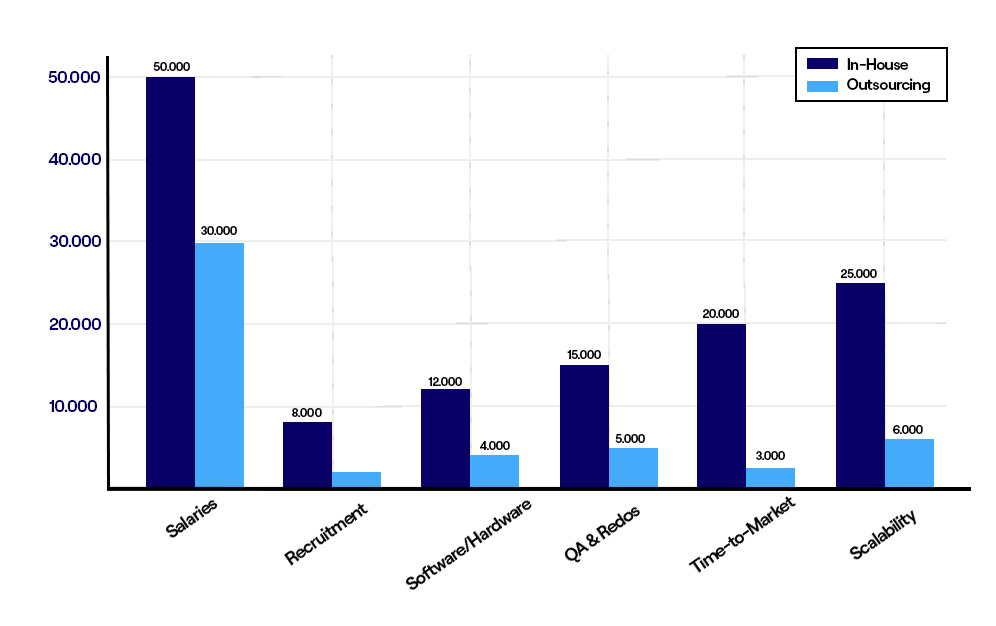Every market place has its own set of rules and not following them will bring unnecessary strain to your investment. The good news is that you don’t have to spend months training your in-house team in every market place you want to publish.
According to McKinsey & Company, one of the world’s leading management consulting firms advising Fortune 500 companies on strategy and operations, “outsourcing isn’t just about swapping providers, it’s about redesigning digital journeys end to end.”
Companies that only hand off a fragment of the process rarely see real gains. The highest impact comes when providers transform the full workflow through optimization, digitization, and automation.
The alternative would be going with the traditional business model and spending a big part of your annual budget to hire photo editors, yearly software subscriptions, build and constantly improve workflows, sequence the automations, and write and develop the scripts that will slowly but steadily decrease the duration of your teams’ tasks.
According to McKinsey, already in 2022, this type of managing product image compliance with an in-house team drains resources, slows time-to-market, and isolates creative and operations teams in a never-ending maze of technical specs. But mostly, it costs more than outsourcing the full process to a Business Process Management provider.
The hidden cost of doing it in-house
Doing things yourselves is, at first glance, a solid choice because it allows your company to
control native processes while remaining independent from other companies, teams, etc. But in this case your company will end up with much higher costs delivering only a fraction of what an established service provider can offer you. For example, Doopic can process up to 20.000 images per day with a price range per image between 0,50 € and 3 €.
When you look at the Total Cost of Ownership (TCO), an in-house team quickly adds up. Beyond salaries, benefits, and recruitment, you face recurring technology expenses such as annual software licenses, hardware, and maintenance. Add to that project and QA management time, the cost of rework from rejected images, delays in time-to-market, plus the upkeep of DAM, (Digital Asset Management) systems and creative workflows. And on top of that, these costs are variable, when outsourcing pricing remains much more stable.

According to Glassdoor Germany, one of the largest recruiting platforms, entry-level designers in Europe earn between €46K and €56K annually (source). Even at peak productivity, an in-house designer needs on average 10 minutes per image which accounts at best for roughly 960 per month once vacation and sick days are factored in. By contrast, companies like Doopic deliver up to 20,000 images per day, ensuring full marketplace compliance after only a short onboarding process.
Is not about being compliant with one marketplace
but being online before with the maximum quality product images
The same applies to ecommerce platforms. Amazon, Zalando, Decathlon or Otto, each has its own “dress code”. Pure white backgrounds, exact crop ratios, no logos, no watermarks. If you don’t comply, you don’t get to compete.
Managing all of this in-house adds no strategic value. At best, it means checking boxes; at worst, it drains resources just to avoid disqualification.
Last update 24.09.2025
This table only shows a few requirements, but many market places have many more and most of the time these defer from each other. And so the real bottleneck isn’t knowing the rules for each marketplace but the time it takes to meet them all.
Each marketplace adds dozens of requirements that slow in-house teams down and fragment their workflows. Specialized providers, by contrast, process compliance at scale because it’s already built into their systems.
This is what McKinsey refers to in their article “Getting business process outsourcing right in a digital future” as the shift from fragmented tasks to end-to-end ownership:
“Companies can no longer outsource a single, fragmented slice of a process and hope to see much improvement in results. Instead, the provider usually needs to own—and transform—the entire end-to-end process.”
The same applies in reverse. If you're handling only fragments of compliance in-house, you’re not set up to win. You’re just barely avoiding failure.
In 2025 we are still at the beginning of the artificial intelligence revolution and yet its impact is already tremendous. This shift requires processes to become more specialized, supported by tailored workflows, automation, and the ability to scale into new markets. As McKinsey notes, managing this level of complexity is more than any single company can realistically handle.
But there is another tangible aspect about this turning point that it’s worth considering. Companies that will try to take the in-house approach will have to compete with those who streamline their processes with specialized BMP providers which are more cost-effective.
Why not just automate with scripts?
Automating our own processes is always a good idea. The more repetitive tasks we can delegate to robots the better. But here is the catch, marketplace requirements are not static. From our own experience, Amazon, Zalando, Globus, Breuninger, tend to update their specifications frequently, and with each update your team is forced back into debugging mode. McKinsey points out that fragmented solutions like these fail to create real efficiency gains because they add complexity without transforming the end-to-end process.
Scripts also address only part of the problem. They can resize or rename files, but they cannot deliver the exact margin ratios, background treatments, or quality checks that compliance requires at scale flawlessly . Integrating them into DAM or CMS systems adds technical overhead, while scaling them beyond a few hundred images exposes their limits.
To reach enterprise-level throughput with stable results, companies need robust workflows, distributed infrastructure, and quality assurance all of which drive up costs. This is why McKinsey recommends hybrid models where technical execution is outsourced to specialized providers: only full process ownership produces measurable advantage.
How Doopic helps creates tailored workflows that put you online before in every market place
Outsourcing image compliance isn’t just a vendor switch. It’s a strategic realignment that allows your internal team to lead creative direction and brand storytelling free of dealing with the heavy backlogs and time consuming processes required for each marketplace. It doesn’t matter whether you need 3.000 or 50.000 images per year. Working with Doopic will always cost your company much less and give you much better results.
In the hybrid model recommended by McKinsey and BCG:
- Tier 1 (Creative Direction) stays in-house
- Tier 2 (Technical Execution + Compliance) goes to expert partners
That’s how the most agile, profitable ecommerce companies scale. So ask yourself:
Is compliance helping you compete? Or is it holding back your best people?
One of today’s biggest challenges is integrating ever-evolving AI tools profitably into complex production workflows. Success requires not only designing processes that can manage individual steps in isolation, but also ensuring every step can be revised and optimized when requirements change.
Let Doopic handle the operational maze, so your team can focus on what they do best.
Would you like to see how this works with a demo? Let’s talk.

.jpg)


